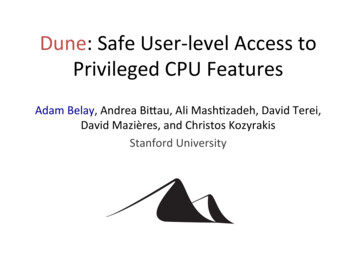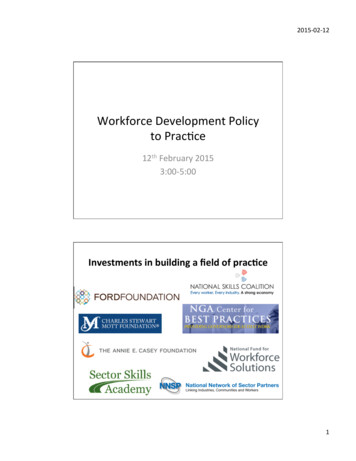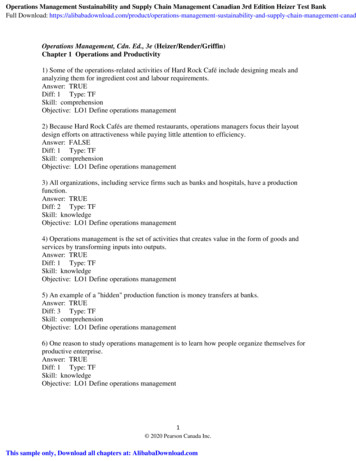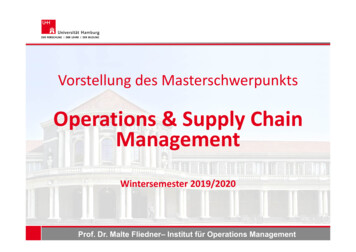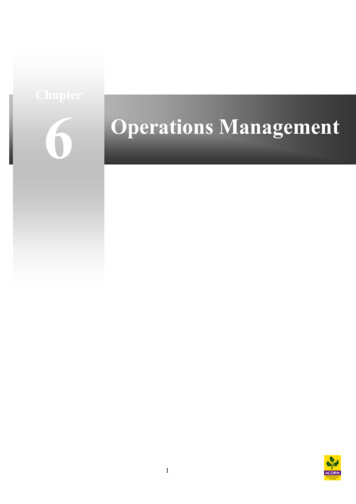
Transcription
Development & OperationsDevOps IntroductionLearning Objective Understanding DevOpsTopics Covered What is DevOps? Evolution of Software Methodologies Waterfall Agile Disadvantages of traditional SDLC Why DevOps? Dev Challenges v/s DevOps Solution Ops Challenges v/s DevOps Solution Stages Of DevOps Lifecycle Continuous Development Continuous Testing Continuous Integration Continuous Deployment Continuous Monitoring The Various DevOps Tools Introduction Roles and Responsibilities of a DevOps Engineer How DevOps fits in the whole Software Development Lifecycle
Physical and Virtual Computing EnvironmentLearning Objective Computing Environments and Getting Started with VirtualizationTopics Covered Computing Environments and Operating Systems Personal Computing, Server- Client Understanding Virtualization Understanding Hypervisor Hosted BaremetalHands-On Setting up a Virtual Machine with Linux OSLinux for DevopsLearning Objective Understanding Linux OS and Basic Shell CommandsTopics Covered What is Linux and Open Source Linux Distributions Understanding Local User in Linux Understanding Linux Hierarchy Understanding Shell Understanding Absolute and Relative Path Working with Text Editors Creating Files and Directory Using CLI
Understanding Linux Command and Using Options for Linux Commands Understanding Globbing, Pipe, Tee Understanding Variables, OperatorsHands-On Executing Basic Shell Commands - cd, ls, vim, nano, touch, mkdirFile and Directory Management - cp, mv, rmCommands with Pattern MatchingWriting Simple Shell ScriptsProgramming with PythonLearning Objective Getting Started with Python and Writing Python ProgramsTopics Covered Introduction to Python: What is Python and why to learn Python as a DevOpsengineer? Installation and Setup Local Development Environment Write Simple Python program Python IDE vs simple File Editor Strings and Number Data Types Variables Encapsulate Logic with Functions Accepting User Input Conditionals (if / else) and Boolean Data Type Error Handling with Try / Except While Loops Lists and For Loops Comments in Python Sets Built-In Functions Dictionary Data Type
Modularize your project with Modules Packages, PyPI and Pip Object Oriented Programming: Classes and ObjectsHands-On Installation and Setup Local Development EnvironmentWriting Python ScriptsProject: Countdown AppProject: Automation with Python (Working with Spreadsheets)Project: API Request to GitLabVCS with GitLearning Objective Understanding Git & GitHub (Managing Source Code and What is VersionControl System(VCS)? Understanding AWS Code CommitTopics Covered Why VCS? VCS tools Distributed VCS What is Git & Why Git? Features Of Git Git Workflow Git Configurations Creating Git Repository Syncing Repositories Adding Origin Pushing changes Pulling changes
Clone operation Concepts of Branches Merge Requests Deleting Branches Resolving Merge Conflicts Git Ignore Git Stash Merging BranchesHand-on Lab: Launch EC2 Instance (Windows) and Configure Git Launch EC2 Instance (Linux) and Configure Git Configuring all Git Operations (Creating Local and Setting up Remote Repositoryin GitHub and Code Commit), push, pull, clone, creating branches, merge.Build & Package Manager ToolsLearning Objective What are Build Tools and Package Managers?Topics Covered How to build an artifact? How to run the application artifact? How to publish the application artifact to the artifact repository? Build Tools for Java (gradle and maven examples) Dependency Management in Software Development Package Manager in JavaScript applications - Build and run applications in JS Build Tools Why Build Tools are relevant for DevOps Engineers?
Artifact Repository Manager with NexusLearning Objective Understanding Artifact Repository Manager, TypesTopics Covered What is an Artifact Repository Manager? Install and run Nexus on Cloud Server Different Repository Types (proxy, hosted, etc.) explained Different Repository Formats (maven, docker, npm, etc.) explained Upload Jar File to Nexus (maven and gradle projects) Nexus API and Repository URLs Blob stores Browsing Components - Components vs Assets Cleanup Policies Scheduled TasksContinuous Integration with JenkinsLearning Objective Understanding Integration with JenkinsTopics Covered Challenges before Continuous Integration What is Continuous Integration? Benefits of Continuous Integration Tools of Continuous Integration Introduction to Jenkins Jenkins Plugins
Build Setup in Jenkins Jenkins Pipeline (Use Cases) Create a simple Pipeline Job Full Jenkinsfile Syntax Demo Create a full Pipeline Job Build Java App Build Docker Image Push to Private DockerHub Create a Multi-Branch Pipeline Job Credentials in Jenkins Jenkins Shared Library WebHooks - Trigger Jenkins Jobs automatically Versioning Application in Continuous Deployment Concepts of Versioning in Software Development Increment Application version from Jenkins Pipeline Set new Docker Image version from Jenkins Pipeline Commit Version Bump from Jenkins PipelineHand-on Lab: Launch EC2 Instance (Linux) and Install JenkinsCreating a simple freestyle jobConfigure Git Repository and Build a java applicationBuild docker images and push it to docker hubCreate a simple and multi pipelineContainerizationLearning Objective Understanding Traditional(Physical and Virtual) Application DeploymentMethods) and Containerization Advantages Understanding Docker and Components
Managing Docker in a Standalone InstanceTopics Covered Virtualization vs Containerization What are Containers and Advantages of Containers Architecture of Docker Container Components of Docker Images Registries (Docker Hub, Elastic Container Registry) Managing Docker Service Running a Container(Attached/Detached), Logging in to Container Starting / Stopping / Restarting Containers Container Networking Bridge Host Overlay Managing Storage for Containers Understanding Docker File Docker Hub - Pushing Images to RepositoryHand-on Lab: Launch EC2 Instance (Windows and Linux) and Configure Docker EngineRun a Simple Standalone Webapp ContainerRun an Ubuntu Container to Check Connectivity between ContainersCreating Volume for Containers and Mounting it PersistentlyCreating a Custom Container Image from Another Container / Docker FileContainerization OrchestrationLearning Objective Understanding What is Container Orchestration
Kubernetes ECS/EKSTopics Covered Introduction to Kubernetes Understand the Main Kubernetes Components Node, Pod, Service, Ingress, ConfigMap, Secret, Volume, Deployment,StatefulSet Kubernetes Architecture Minikube and Kubectl - Local Setup Main Kubectl Commands - K8s CLI Create and Debug Pod in a Minicluster Kubernetes YAML Configuration File Create and Configure Deployment and Service Components Organizing your components with K8s Namespaces Kubernetes Service Types Making your App accessible from outside with Kubernetes Ingress Persisting Data in Kubernetes with Volumes Persistent Volume Persistent Volume Claim Storage Class ConfigMap and Secret Kubernetes Volume Types Deploying Stateful Apps with StatefulSet Deploying Kubernetes cluster on a Managed Kubernetes Service (K8s on Cloud) Helm - Package Manager of Kubernetes Creating a ECS Cluster Creating a EKS ClusterInfrastructure as Code with Terraform & Ansible
Learning Objective Terraform and it's componentsTopics Covered What is Terraform? How it works Architecture Providers Resources & Data Sources Variables & Output Values Environment variables in Terraform Terraform commands Terraform State Provisioners Modules Remote State Terraform & AWSHand-on Lab: Create Security Group and Provision EC2 windows or Linux Instance usingTerraform Configure Terraform in Jenkins Automate provisioning EC2 instance from Jenkins pipeline and deploy theapplication with docker-composeLearning Objective Automation with Ansible
Topics Covered What is Ansible, Uses and How Ansible Works. Architecture Control Node Managed Node Inventory Module Play and Playbook Managing Static Inventory Creating Ansible Project Directory and Configurations Understanding Ansible Ad-hoc Commands Privilege Escalation Configuration Understanding YAML and Writing Simple Ansible Playbook Using Variables in Ansible Playbook Using Loop Using Conditions Ansible Roles from Ansible GalaxyHand-on Lab: Launch an EC2 Linux Instance and Configure Ansible Engine Setting Up Linux Managed Nodes Writing a Playbook for Deploying Web Application Deploying Applications from Ansible Galaxy Project: Ansible & Terraform Project: Run Docker applications Project: Run Ansible from Jenkins Pipeline
Google Cloud Platform (GCP) Course Curriculum1. GCP Introduction2. Managing GCP Services3. GCP Networking Services4. Gcp IAM And Security Services5. GCP Compute Services6. GCP Storage And Database Services7. GCP Containers8. Google Cloud MigrationGCP Introduction Google Cloud Platform (GCP) InfrastructureCompute resourcesNetworking ServicesStorage and Database offeringIntroduction to Primitive roleManaging GCP Services Managing GCP environment with GCP consoleControl GCP environment using CLIGCP environment management using Cloud ShellGCP environment management using GcloudGCP environment management using GsutilInstall and configure cloud SDKGCP Networking Services Cloud Virtual NetworkVirtual Private NetworkVirtual Private CloudProxies / Gateway and EndpointsNetwork/SubnetworkDNS Resolution
Firewalls and RoutesCloud RouterInterconnecting networksSecurity aspectGcp IAM And Security Services Understand Identity and Access Management (IAM)Understanding Organizations, Roles, Members, Service accounts,Policy HierarchyUnderstanding different role and permissionGCP Compute Services Understand Compute Engine Understand and implement Compute options (vCPU and Memory)specific to workload Persistent disk – HDD, SSD Load Balancing Common Compute Engine actionsGCP Storage And Database Services Understand Cloud Storage – Nearline, ColdlinePros and cons of storage option and how to chooseUnderstanding Billing aspect of storage optionsTrade off of storage optionsIntegration with on premises/multi-cloud environmentGCP Containers Understand Containers and their benefits Kubernetes Engine, Container Registry How to use Kubernetes Load Balancing How to choose Kubernetes Engine, App Engine, or Containers onCompute Engine
Understanding Virtualization Understanding Hypervisor Hosted Baremetal Hands-On Setting up a Virtual Machine with Linux OS Linux for Devops Learning Objective Understanding Linux OS and Basic Shell Commands Topics Covered What is Linux and Open Source Linux Distributions Understanding Local User in Linux Understanding Linux Hierarchy Understanding Shell Understanding Absolute and Relative Path .



